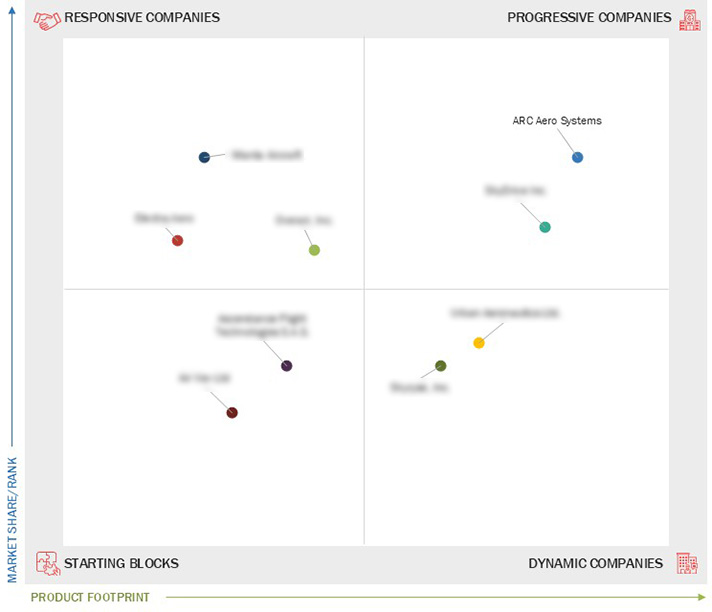Comparing 9 vendors in eVTOL aircraft Startups across 0 criteria.
An electric vertical take-off and landing aircraft (eVTOL) uses fully electric, hybrid-electric, or hydrogen-electric power sources to take off, land, and hover vertically. The eVTOL aircraft is an integral part of advanced air mobility. Technological advancements in aerospace engineering have recently contributed to the development of electric systems, such as electric and hybrid propulsion systems, electric subsystems, and aerostructure. These enhancements have boosted the growth of the eVTOL aircraft.
Market Leadership Quadrant
1.1 Study Objectives
1.2 Market Definition
1.3 Study Scope
1.3.1 Market Segmentation
1.3.2 Inclusions & Exclusions
1.4 Years Considered
1.5 Currency Considered
1.6 Research Limitations
1.7 Stakeholders
1.8 Summary of Changes
2.1 Introduction
2.2 Market Dynamics
2.2.1 Drivers
2.2.1.1 Need for Green Energy and Noise-free Aircraft
2.2.1.2 Increasing Need for Alternative Modes of Transport
2.2.1.3 Demand for Fast Commuting in Metropolitan Cities
2.2.1.4 Technological Advancements in Batteries, Motors, and Power
Electronics
2.2.2 Restraints
2.2.2.1 Regulatory Hurdles
2.2.2.2 High Development and Infrastructure Costs
2.2.2.3 Urban Airspace Congestion
2.2.3 Opportunities
2.2.3.1 Autonomous Operations
2.2.3.2 Regional Air Mobility Expansion
2.2.4 Challenges
2.2.4.1 Cybersecurity Concerns
2.2.4.2 Short Range Due to Battery Limitations
2.3 Value Chain Analysis
2.3.1 Raw Materials
2.3.2 R&D
2.3.3 Component Manufacturing
2.3.4 OEMS
2.3.5 End Users
2.4 Ecosystem Analysis
2.4.1 Oems
2.4.2 Infrastructure Providers
2.4.3 Suppliers of Parts
2.4.4 End Users
2.5 Trends and Disruptions Impacting Customer Business
2.6 Operational Data
2.6.1 Certification Process for EVTOL Aircraft
2.6.2 Noise Levels in Key EVTOL Aircraft Models
2.6.3 Readiness Levels in EVTOL Aircraft Models
2.6.4 Supplier Landscape for Key EVTOL Systems
2.7 Investment and Funding Scenario
2.8 Technology Analysis
2.8.1 Key Technologies
2.8.1.1 Lithium-sulfur Batteries
2.8.1.2 Hydrogen Fuel Cells
2.8.2 Adjacent Technologies
2.8.2.1 Charging and Refueling Infrastructure
2.8.2.2 Simulation and Training
2.9 Key Conferences & Events
2.10 EVTOL Market: Business Models
2.11 Total Cost of Ownership (TCO) Analysis
2.12 Pricing Analysis
2.12.1 Indicative Pricing Analysis of EVTOL Aircraft
2.12.2 Indicative Pricing Analysis, By Region
2.12.3 Comparative Study of EVTOL Aircraft Models
2.13 Bill of Materials (BOM) Analysis
3.1 Introduction
3.2 Key Player Strategies/right to Win, 2020–2024
3.3 Revenue Analysis
3.4 Market Share Analysis
3.5 Market Ranking of Top Five Players Based on Deals, 2021–2024
3.6 Order Book Share Analysis, 2024
3.7 Company Evaluation Matrix: Startups/smes, 2023
3.7.1 Progressive Companies
3.7.2 Responsive Companies
3.7.3 Dynamic Companies
3.7.4 Starting Blocks
3.7.5 Competitive Benchmarking
3.8 Company Valuation and Financial Metrics
3.9 Brand/product Comparison
3.10 Competitive Scenario
3.10.1 Product Launches
3.10.2 Deals
3.10.3 Other Developments
4.1 ARC AERO SYSTEMS
4.1.1 Business overview
4.1.2 Products/Solutions/Services offered
4.1.3 Recent developments
4.2 SKYDRIVE INC.
4.2.1 Business overview
4.2.2 Products/Solutions/Services offered
4.2.3 Recent developments
4.3 ELECTRA.AERO
4.3.1 Business overview
4.3.2 Products/Solutions/Services offered
4.3.3 Recent developments
4.4 OVERAIR, INC.
4.4.1 Business overview
4.4.2 Products/Solutions/Services offered
4.4.3 Recent developments
4.5 MANTA AIRCRAFT
4.5.1 Business overview
4.5.2 Products/Solutions/Services offered
4.5.3 Recent developments
4.6 AIR VEV LTD
4.6.1 Business overview
4.6.2 Products/Solutions/Services offered
4.6.3 Recent developments
4.7 URBAN AERONAUTICS
4.7.1 Business overview
4.7.2 Products/Solutions/Services offered
4.7.3 Recent developments
4.8 SKYRYSE, INC.
4.8.1 Business overview
4.8.2 Products/Solutions/Services offered
4.8.3 Recent developments
4.9 ASCENDANCE FLIGHT TECHNOLOGIES S.A.S
4.9.1 Business overview
4.9.2 Products/Solutions/Services offered
4.9.3 Recent developments


 flightglobal
flightglobal
 Nov 2024
Nov 2024

